Interiors
What do these photos tell you about the interior of the houses these miners lived in?
Miners in a Frame Cabin
This is the interior of a miner’s cabin. This room is used as the bedroom, dining room, and kitchen. The cabin also had an upstairs loft that was probably used for sleeping. One can see the ladder to the loft on the wall next to the bed. Much of the furniture is homemade.
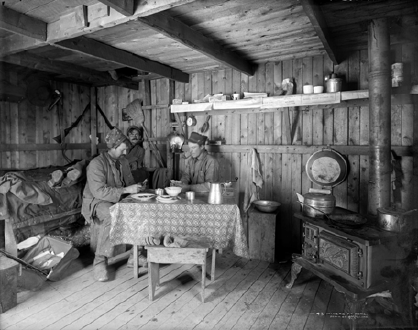
Photo: Denver Public Library, Western History Collection
More About This Topic
Most miners’ cabins were very simply furnished. The cabin in this photo had a bed, dining table, wooden stools, a box used as a washstand, and a shelf nailed to the wall. All of the furniture except the stove probably was homemade.
Their Own Words
"Dore's was just the usual miner's cabin--a bunk built in one corner, a mattress of straw or pine boughs and over this blankets, with a top cover of canvas, and a pillow with a dark calico slip (quite shiny in the middle). At the head of the bed is a shelf, either nailed or on pegs set in the logs; on this shelf are matches a candle, pipes and tobacco, shaving mug and razor, and a small box holding thread, needles, and buttons. Against the wall is a home-made table, on which are cans containing sugar and salt; also a can of condensed milk, a few tin plates and cups, these being turned upside down when not in use, to keep mice and dirt out. Over the dishes knives and forks, the dishpan was turned; on top and covering all this was spread the not very white dish-towel, made from an old flour sack. The chairs were of blocks of wood, or two pieces of board nailed on a slant, with a seat fastened on; the stove was a tiny sheet-iron affair with a coffee-pot on the back. Under a curtain the corner hung their 'other clothes'. . . ."
Source: Anne Ellis, The Life of an Ordinary Woman, (Lincoln: University of Nebraska Press, 1929, 1980): 31-32.
Two Miners Sitting in a Cabin
The two miners in this photo are sitting beside the iron stove used for cooking and for heat during the winter.
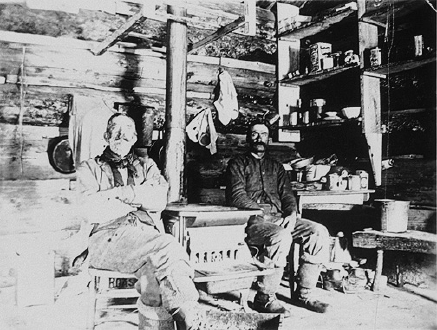
Photo: Denver Public Library, Western History Collection
More About This Topic
Everyday life in a miners’ cabin centered around the dining table and the stove. In many cabins the stove was the only store-bought piece of furniture. It was used for cooking, heating, and companionship. In cold weather, miners gathered around the stove to talk or read.
Their Own Words
"Some time along here we moved a mile up the road from town to what we called the Rawley Gulch house. This was a three-room affair built in the hillside, the rooms all in a row; the kitchen quite low and dark; the canvas bulging off the walls…. The middle room was quite small, and had in it a trunk and a single bed; also a home-made desk kept under lock and key…. In the front room were two beds and a stove. It was around this stove we gathered to hear Henry read Rider Haggard’s She and Allan Quatermain to us. And the thrill of those stories! I believed every word of them."
Source: Anne Ellis, The Life of an Ordinary Woman (Boston: Houghton Mifflin Company, 1929): 53-54.
Interior Of a Log Cabin
Two miners are sitting at their dining table in this photo. The table, chairs, and stool are homemade.
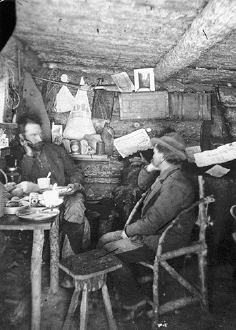
Photo: Colorado Historical Society
More About This Topic
Miners traveled light. They arrived in Colorado on horseback, driving a farm wagon or in a stagecoach. They brought some food with them, extra clothing, but little else. Few could afford the cost of hauling or shipping furniture. That is why the miners’ tables, chairs, and much of their other furniture was home-made. Still, a simply furnished log cabin was more comfortable than living in a small room in a hotel or boarding house.
Their Own Words
"I remember that when I first took a room in Victor I was rather disturbed because, although it had a door lock of sorts, there was no key.... Nothing of mine was ever stolen. The room in the lodging house...was a cubicle rather than a room. It contained a bed, an affair on legs which had two small drawers and which supported a wash bowl and pitcher, and a stove.... It was the smallest stove I have ever seen outside of a toy shop. A tiny sheet-iron cylinder with a stove pipe about as thick as my wrist.... There were six rooms like that on the upper floor of this lodging house, each renting for $10.00 a month."
Source: Leo J. Keena, " Cripple Creek in 1900," Colorado Magazine, 30 (1953): 271.
Interior Of The Peyer's House
This is the sitting room of a well-to-do family in Leadville. The furniture included a piano and a couch. The room also had carpet on the floor.
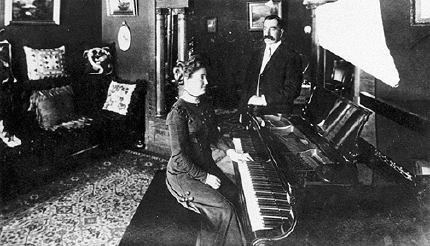
Photo: Colorado Historical Society
More About This Topic
The furniture that people own is a good indication of their wealth and social standing. At the top of mining town society were the mine owners, mine superintendents, and successful merchants. They could afford to have fine furniture and ship it across the plains. Wealthy families who settled in mining towns brought their best furniture with them.
Their Own Words
"The [living] room is very attractive, for you know father bought all our good furniture: the upholstered chairs, the easy chair, the couch and bookcase full of books, besides our piano; although this is small, it is nice mahogany, but I fear the dry climate will injure it, for already there are little cracks in the veneer and the sounding board has split in one place. My mother brought lace curtains and has plants in bloom in the windows, and against the snow outside they look bright and cheery."
Source: Emma Shepard Hill, A Dangerous Crossing and What Happened on the Other Side (Denver, 1924): 55.
Interior Of The Healy House
This is a room in the Healy house in Leadville. It was furnished with drapes, carpets on the floor, and fine furniture.
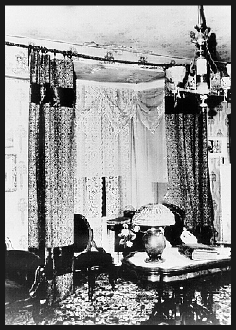
Photo: Colorado Historical Society
More About This Topic
The wall covering, curtains, and carpets in people’s houses also indicated what they did in mining camps. The cabins of ordinary miners had bare walls and floors. The men who owned mines and smelters could afford wallpaper and carpets. This house was built in 1878 by August R. Meyer, who owned a smelter in Leadville. He later sold it to Daniel Healy.
Interior Of An Expensive House
This is the library or reading room in a house in Leadville. It is furnished with bookcases, chairs, and a table. The fireplace is decorated with vases and a sculpture.
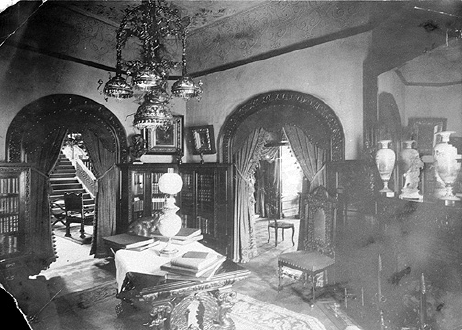
Photo: Colorado Historical Society
More About This Topic
Wealthy mine owners lived in mansions. The house shown in this photo had a nicely furnished sitting room. It also had a library or reading room. This wealthy family could afford to decorate the house with pictures in frames, vases and sculptures.

